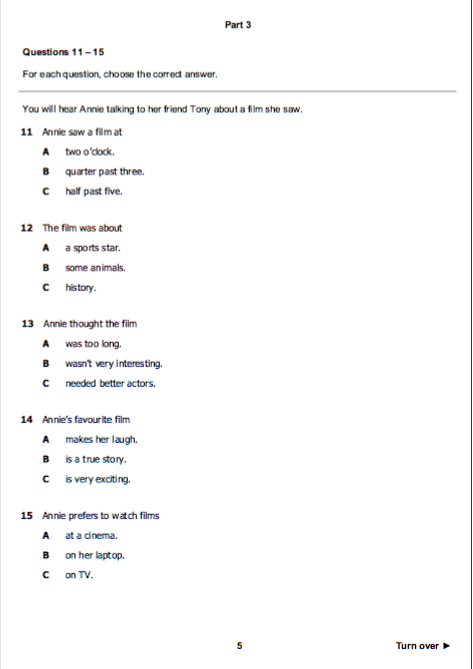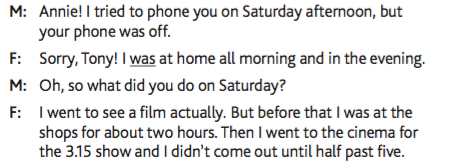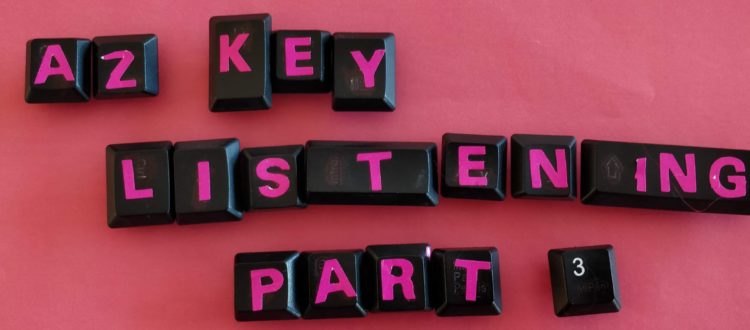About A2 Key (for Schools) Listening Part 3
Today’s post will examine A2 Key (and A2 Key for Schools) Listening Part 3
Let’s look at the Part 3 Listening from the A2 Key for Schools Handbook. You can find this, and other resources, here: https://www.cambridgeenglish.org/teaching-english/resources-for-teachers/

What’s in this Part?
In Part 3 of the A2 Key Listening Test, candidates listen to an informal conversation between two people (in this case, Annie and Tony). The conversation might be face-to-face or on the phone.
They have to answer five multiple choice questions, with three options (A, B and C)
Important facts to know
- The answer for each question may come from either speaker.
- Some of the questions will focus on detail and others will test the understanding of opinions and attitudes.
- As usually happens with multiple choice reading and listening tasks, students should expect to hear some reference to all three options – even if it is just one or some of the words in the option.
How to approach this Part
1 Read the information about the speakers and what they will be talking about.
You will hear Annie talking to her friend Tony about a film she saw.
In this example, we know that Annie and Tony are friends and they are speaking about a film that Annie saw. We will hear a female voice and a male voice.
2 Read through the questions before the conversation starts.
Tell students is to use the time that they have (20 seconds) before the conversation starts to read the five questions. *But not the options.
This will give them an idea of the content (and the structure) of the conversation.
We can see that some of the questions will probably refer to the past, about Annie’s visit to the cinema and the film she saw. Questions 11, 12, 13 refer to her trip to the cinema and the film that she saw.
11 Annie saw a film at:
12 The film was about
13 Annie thought the film
Questions 14 and 15 seem to refer to the present and to Annie’s opinions.
14 Annie’s favourite film
15 Annie prefers to watch films
3 Read the first question and the three options
After reading as many of the five questions as possible, when the conversation begins, candidates should then turn their attention to the first question (11) and the three options for that question.
11 Annie saw a film at:
A two o’clock
B quarter past three
C half past five
Let’s look at the tapescript for this question:

The first thing to notice is how much time candidates have before the first answer is given.
4 Use the start of the conversation to get used to the speakers’ accents and delivery.
5 Expect to hear a mention of all three options.
As you can see, all three numbers are mentioned – Annie was at the shops for two hours. She saw the 3.15 show and came out of the cinema at half past five.
The answer is B – quarter past three, but we hear this in a different way – three fifteen.
We hear the time for C in exactly the same words – half past five – but that would answer: ‘The film finished at’ or ‘Annie left the cinema at’
We don’t hear the time in option A, but we do hear the number.
6 There are no numbers on the audio, but pauses or phrases will indicate where information relevant to the next question will come.
Let’s look at question (12) and the tapescript.
12 What was the film about?
A a sports star
B some animals
C history

Tony indicates that the next answer is coming by asking his question: What was the film?
And in just two sentences, Annie tells us the answer (a top baseball player – A – a sports star), and we have two words that could lead use to choose the wrong options – B and C. Candidates might choose B because they hear the word Lions. And they might choose C history because they heard the word story.
7 Avoid ‘wordspots’
13 Annie thought the film
A was too long
B wasn’t very interesting
C needed better actors

Students might ‘wordspot’ and choose B because they heard the word interesting or A because they hear Annie say it’s not too long.
Candidates might not know the expression it’s a shame, but they can probably guess the meaning and get the right answer (C) from the rest of that phrase: there are no really good actors in it.
8 Correct answers are usually paraphrases of the audio.
Question 14
Again, Tony cues the answer to question 14 by asking a question: Don’t you prefer funny films?
14 Annie’s favourite film
A makes her laugh
B is a true story
C is very exciting

Candidates might choose the wrong options (A and C) because Annie says the words funny and amazing. The correct option (B) is a true story is paraphrased in the audio as it all really happened.
9 Remember to focus on the key word(s) in the question.
Question 15
15 Annie prefers to watch films
A at a cinema
B on her laptop
C on TV

Again, all three options are mentioned, but A answers the question (Annie prefers to watch films).
Students might choose B if they are thinking of the sentence: Annie usually watches films, for example.
A quick recap (and more tips)
Candidates should:
1 Use the time before the conversation starts to read through the five questions.
2 Expect to hear all the options on the recording. Some will be answers to other questions. Some will be similar to words they hear (e.g. history – story).
3 Avoid ‘wordspotting’ (choosing answers because they contain words that they hear on the audio).
4 Choose an answer for every question, even if they are not sure or missed the answer on the audio.
5 Use the second listening to check their answers and to answer any questions they missed the first time they listened.
6 Wait until the end of the whole listening paper to transfer their answers. They are given 6 minutes to do this.
One final, important tip!
Make sure that students get regular practice in listening to dialogues of this length, so that they become confident with longer recordings.

